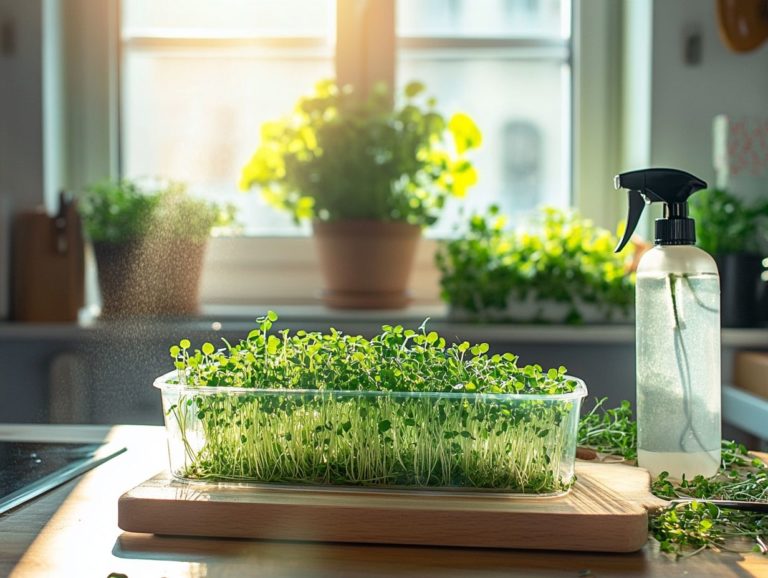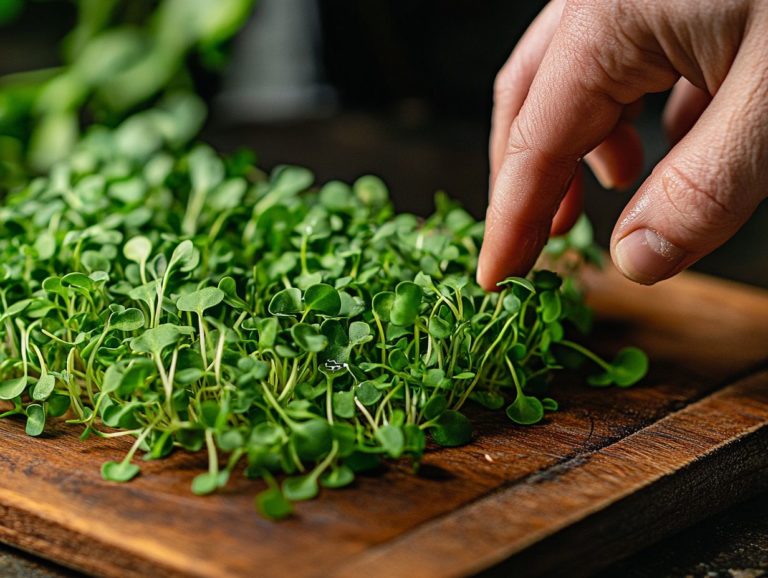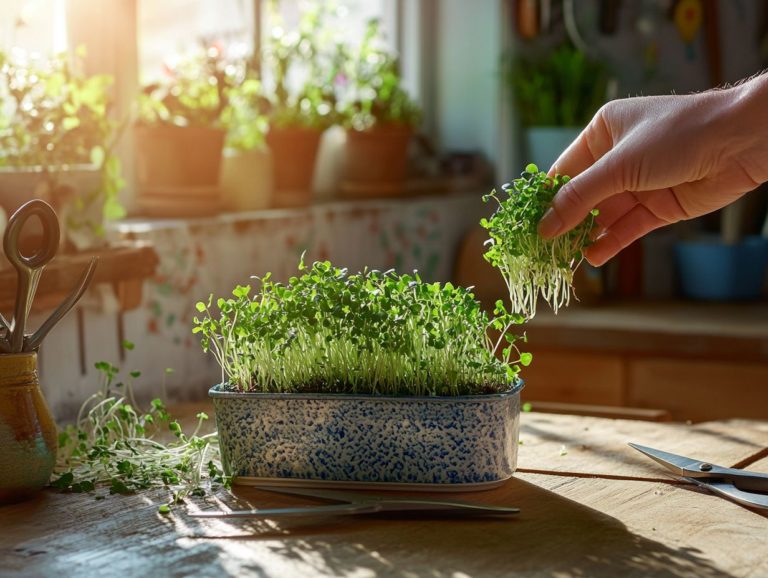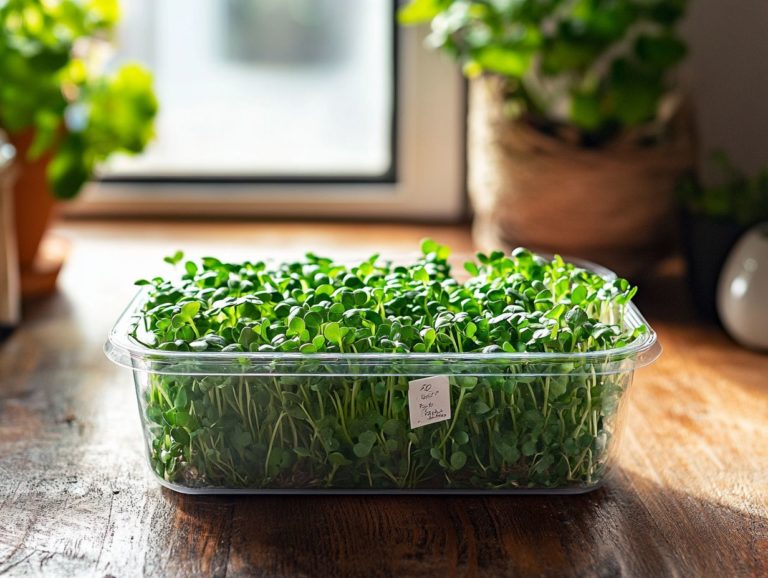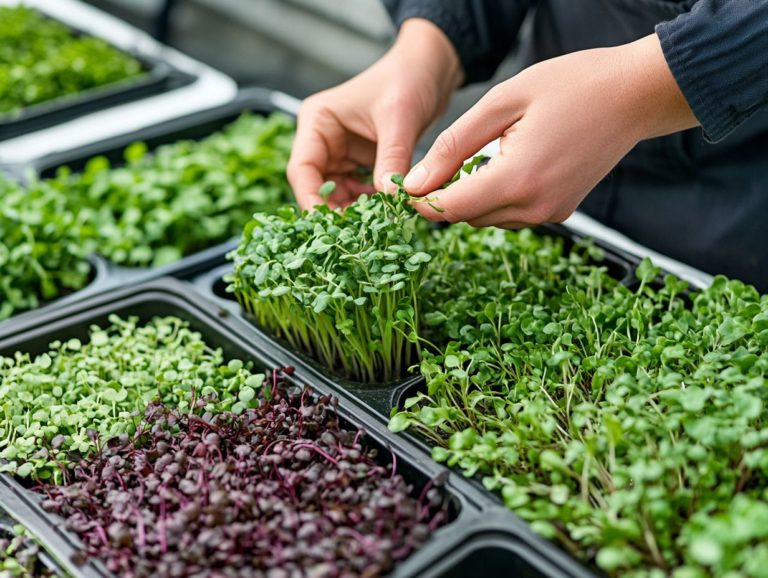How to Care for Microgreens After Harvest
Microgreens are far more than trendy garnishes; they offer a delightful burst of flavor and an impressive nutritional profile.
In this exploration, you’ll uncover their definition, discover various types, and master the best techniques for harvesting and storing them. You’ll learn exciting ways to keep your microgreens fresh and bursting with flavor!
You ll discover creative ways to add these petite greens into your culinary creations and d cor. Immerse yourself in this journey to elevate your meals with the remarkable world of microgreens!
Contents
Key Takeaways:
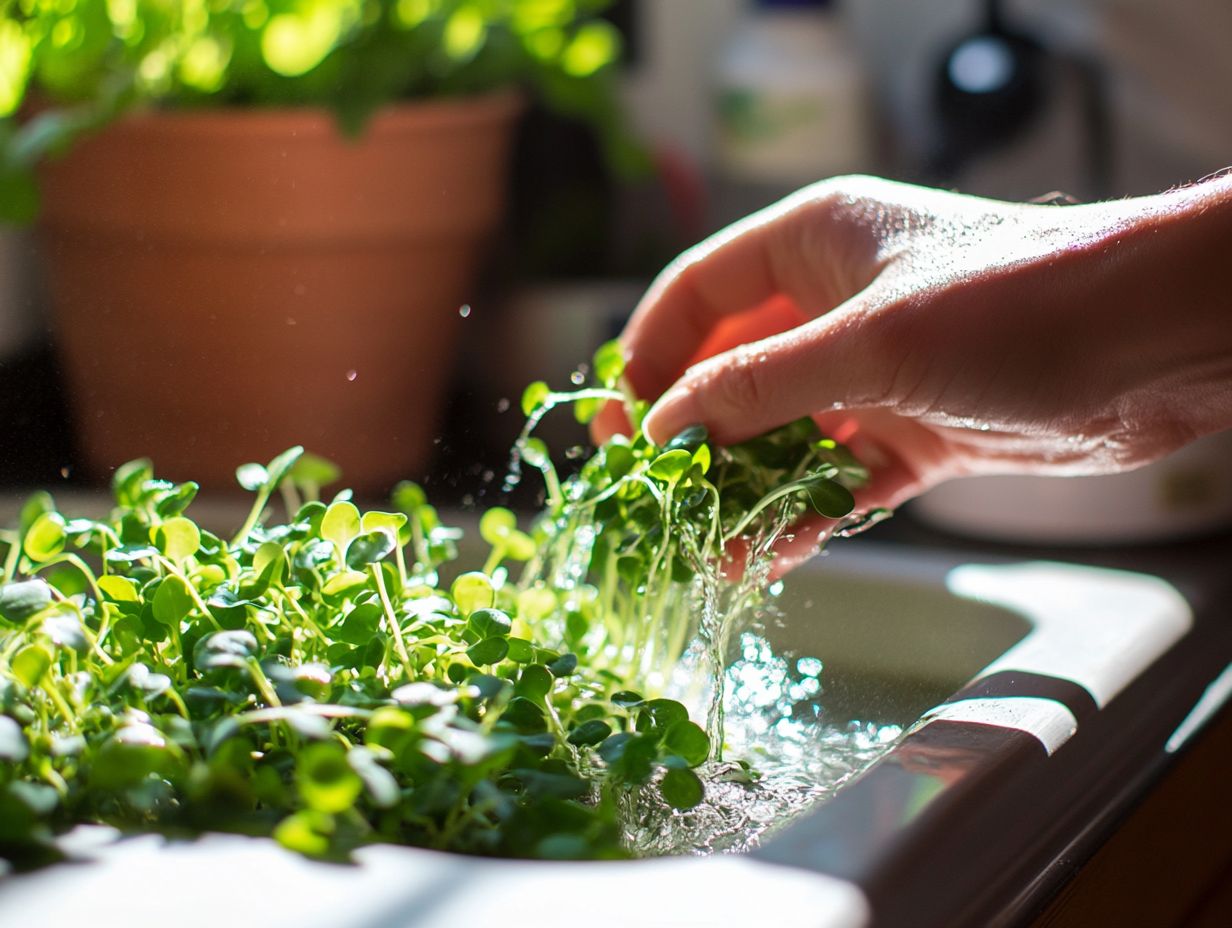
- Store microgreens in a sealed container with a paper towel to keep them fresh and flavorful.
- Water regularly and provide sunlight to keep microgreens healthy and nutritious.
- Get creative! Use microgreens to add color and flavor to your favorite dishes.
What are Microgreens?
Microgreens are young, edible plants that you can harvest at an early stage, usually between 7 to 21 days after they’ve germinated. They come from various plant families, including Brassicaceae, Cucurbitaceae, Asteraceae, Amaranthaceae, Apiaceae, and Amaryllidaceae, offering you a delightful range of flavors and textures.
As a type of vegetable, they re incredibly full of nutrients packed with beneficial compounds, vitamins, and nutrients. Their vibrant colors and unique flavors not only elevate the visual appeal of your dishes but also enhance their overall value.
What Microgreens Are and Their Types
Microgreens are those delightful little edible greens you harvest from various seedlings, including members of the Brassicaceae, Cucurbitaceae, Asteraceae, Amaranthaceae, Apiaceae, and Amaryllidaceae families.
Each family brings its own unique flavors and nutritional benefits, making them incredibly versatile in the kitchen. For example, the Brassicaceae family includes broccoli and radish microgreens, which offer a peppery kick packed with vitamins A, C, and K to boost your immune health.
Then there s the Cucurbitaceae family, featuring cilantro microgreens. With their bright, zesty flavor, they re perfect for garnishing dishes while also delivering a healthy dose of beneficial compounds.
From the Asteraceae family, you have arugula microgreens, cherished for their distinct, slightly bitter notes that elevate salads and sandwiches.
And let s not forget the Amaranthaceae family, which introduces vibrant beet greens known for their earthy taste and impressive iron content.
All in all, these young greens enhance the visual appeal of your meals and contribute to a nutrient-rich diet that you can feel good about.
Harvesting Microgreens
Harvesting microgreens demands your keen eye for timing, ensuring you cut them at just the right moment for optimal freshness and flavor. Balancing moisture levels is crucial, as it significantly enhances their shelf life.
This delicate process requires meticulous attention to detail; after all, the timing can directly influence both nutrient retention and taste. By mastering the art of cutting microgreens, you ll elevate your culinary experience while maximizing their health benefits.
When and How to Harvest
Harvest your microgreens when the first true leaves appear. This signals they re ready for cutting and consumption.
Recognizing this stage is crucial as it affects both flavor and nutritional value. Keep an eye on height and leaf development to know when to harvest.
A gentle touch is essential during cutting. Using sharp scissors or shears ensures a clean cut, preserving the quality of the remaining plants.
For an added boost in freshness and taste, consider harvesting in the early morning when the plants are brimming with moisture. Proper handling will minimize bruising and maintain their crisp texture, guaranteeing the best possible eating experience.
Storing Microgreens
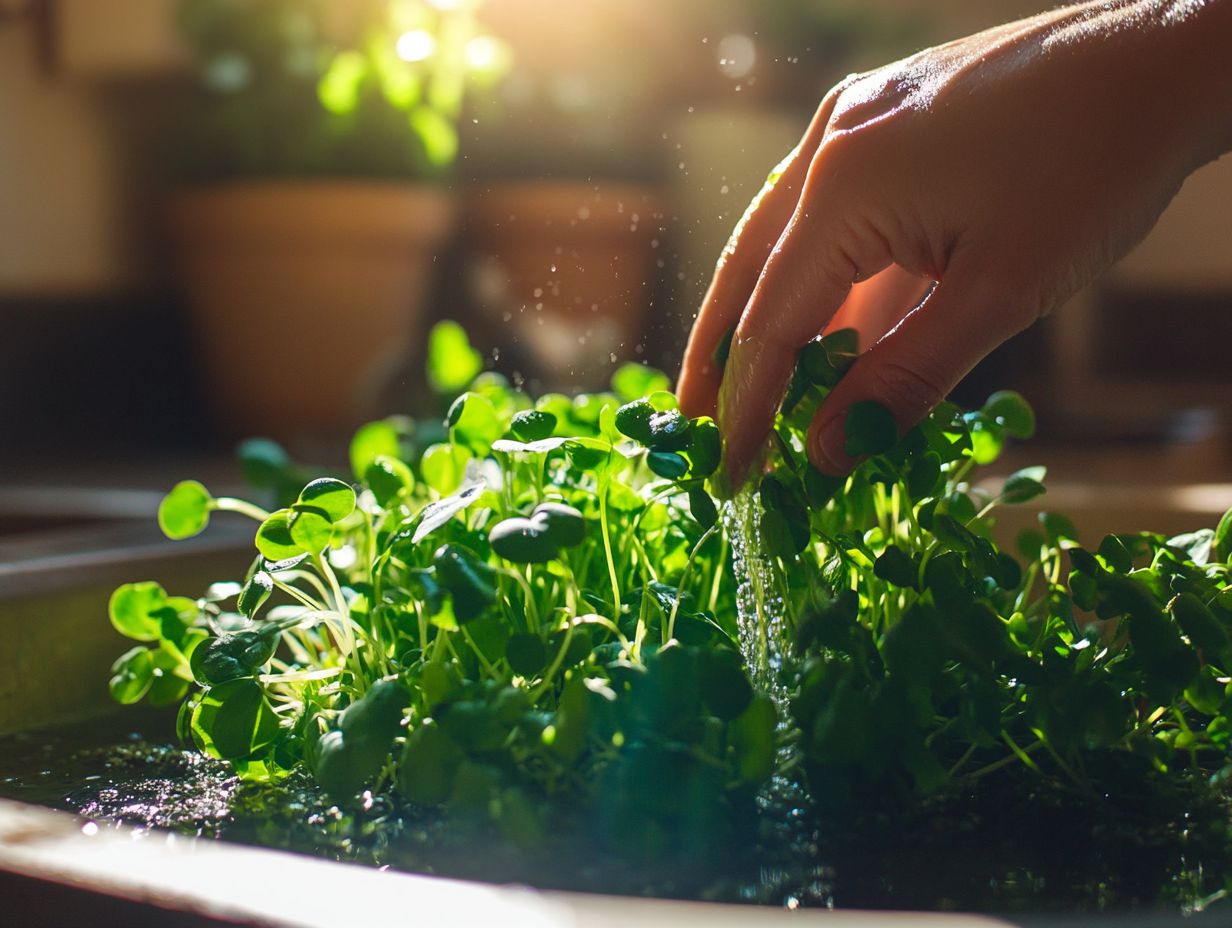
Storing microgreens properly is crucial for maintaining freshness and extending shelf life. This ensures that these nutrient-dense vegetables continue to offer remarkable health benefits.
By employing the right storage techniques, you can prevent spoilage and preserve their vibrant colors and crisp textures, allowing you to savor their full flavor and nutritional value.
Proper Storage Techniques
To store microgreens properly, wrap them in a damp paper towel and place them in a container that allows air circulation. This technique helps maintain the perfect moisture balance while preventing excess humidity.
This ensures your microgreens retain their vibrant color and crisp texture, essential qualities that make them a favorite for salads and garnishes. To keep them healthy, consider using the right watering techniques for thriving microgreens. Be cautious; sealing them in airtight containers can lead to condensation and encourage mold growth.
Keep them in the refrigerator s crisper drawer, where the temperatures are just right for freshness. Regularly check the paper towel for dampness. This is crucial for extending their shelf life, allowing you to enjoy the full spectrum of flavors and nutrients.
Caring for Microgreens After Harvest
Caring for your microgreens after harvest is essential for maintaining freshness. Pay close attention to their watering and sunlight needs to prevent issues like mold or disease.
Microgreens are sensitive to their environment. Providing the right care extends their usability and amplifies their health benefits. Keep them thriving to enjoy their vibrant flavors and nutrients for longer.
Watering and Sunlight Requirements
Microgreens require attention when it comes to watering and sunlight to truly thrive post-harvest. Getting it just right can make a difference in their health benefits and freshness.
These delicate seedlings do best in a balanced environment where moisture is managed, avoiding saturation. Proper drainage allows the roots to sip just the right amount of water while steering clear of mold and root rot.
Sunlight is equally vital. Insufficient light can result in weak, leggy plants that fall short of delivering the vibrant flavors and nutrients you expect. Aim for 12 to 16 hours of indirect sunlight each day to promote robust photosynthesis, the process plants use to make food from sunlight, ultimately enhancing their nutritional profile.
Understanding these environmental needs is crucial for anyone eager to cultivate and reap the full benefits of microgreens, which are easy to grow at home.
Try harvesting your microgreens today and taste the difference for yourself!
Preventing Mold and Disease
Preventing mold and diseases in your microgreens is all about mastering controlling water levels and ensuring proper air circulation so your seedlings stay healthy and safe for consumption.
Finding the right balance of humidity and airflow is essential. Too much moisture can turn your setup into a haven for pesky fungi and bacteria. To keep this in check, make it a habit to monitor how wet the soil is closely. Water only when necessary, and opt for well-draining soil.
You can also enhance air circulation by placing your microgreens in a well-lit area with enough space between trays. By maintaining these key environmental factors, get ready to enjoy a treasure trove of flavorful microgreens. For a detailed approach, follow this step-by-step guide to sowing microgreens that taps into their myriad health benefits while promoting robust growth that elevates both flavor and nutritional value.
Creative Ways to Use Microgreens
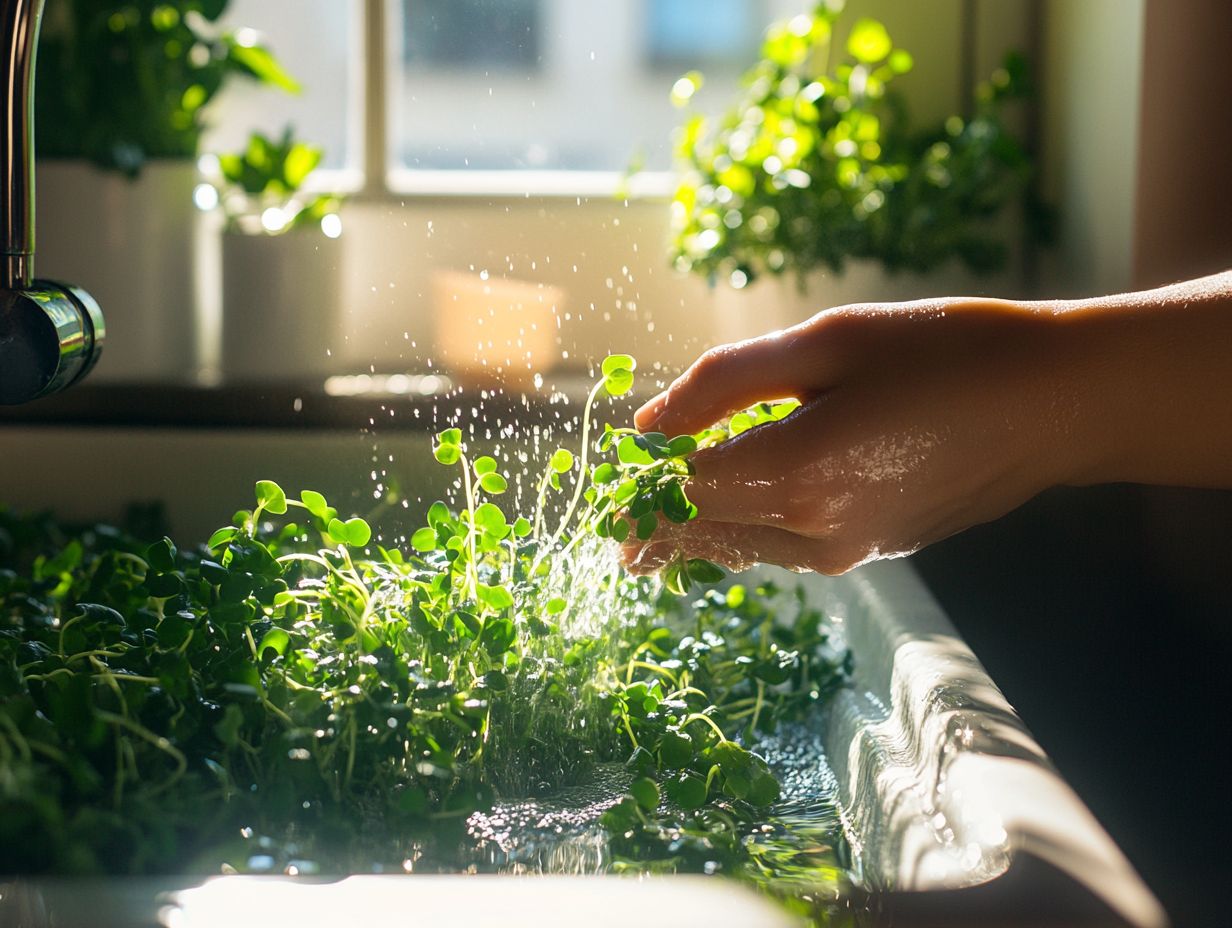
Microgreens present a world of creative possibilities in both culinary and decorative realms, infusing your dishes with vibrant flavor and nutrition. Their fresh, nutrient-rich profile makes them ideal for garnishing plates or elevating salads and smoothies.
This versatility not only adds a unique flair to any meal but also delivers a host of health benefits, ensuring your dining experience is both delicious and nourishing.
Culinary and Decorative Uses
Microgreens are not just a trend; they re the unsung heroes of the culinary world, renowned for their ability to add a vibrant splash of color and a burst of flavor to your dishes, enhancing the entire dining experience.
These tiny nutrient-rich plants can effortlessly elevate a range of recipes, from crisp salads that tease the palate to gourmet sandwiches that benefit from their delightful crunch. Take a simple avocado toast, for instance. Add a sprinkle of radish microgreens and watch it transform into a culinary masterpiece. Not only do they deliver a peppery kick, but they also enhance the dish’s visual allure. To ensure optimal flavor and freshness, it’s crucial to know the best time for harvesting. Refer to this timing your microgreens guide for tips on when to harvest.
You can use microgreens to garnish soups, providing a refreshing finish, or to crown main courses like grilled fish, where they complement the flavors beautifully. For those interested in growing their own, learning How to Use Hydroponics for Microgreens can enhance your culinary experience. Their aesthetic charm makes microgreens an ideal choice for plating, turning even the simplest meal into an artful presentation.
Tips for Maintaining Healthy Microgreens
Maintaining healthy microgreens requires consistent care, including proper watering, sunlight exposure, and effective pest management. Each of these factors plays a crucial role in enhancing their overall health benefits and freshness.
For optimal growth, ensure these tiny plants receive around four to six hours of indirect sunlight each day. This approach allows them to thrive while avoiding the risk of wilting or burning.
In terms of watering, using a fine mist is key; it maintains moisture levels without overwhelming them, resulting in a robust flavor profile and excellent nutrient retention.
Regularly checking for pests not only protects your microgreens but also amplifies their natural taste while keeping them free of unwanted chemicals. Act now to protect your plants and savor every delicious bite!
Frequently Asked Questions
How do I care for cut microgreens after harvest?
To keep your microgreens fresh after harvest, gently remove any excess soil or debris from the greens and rinse them with cool water. Then, gently pat them dry with a clean towel or paper towels.
Do I need to refrigerate microgreens after harvest?
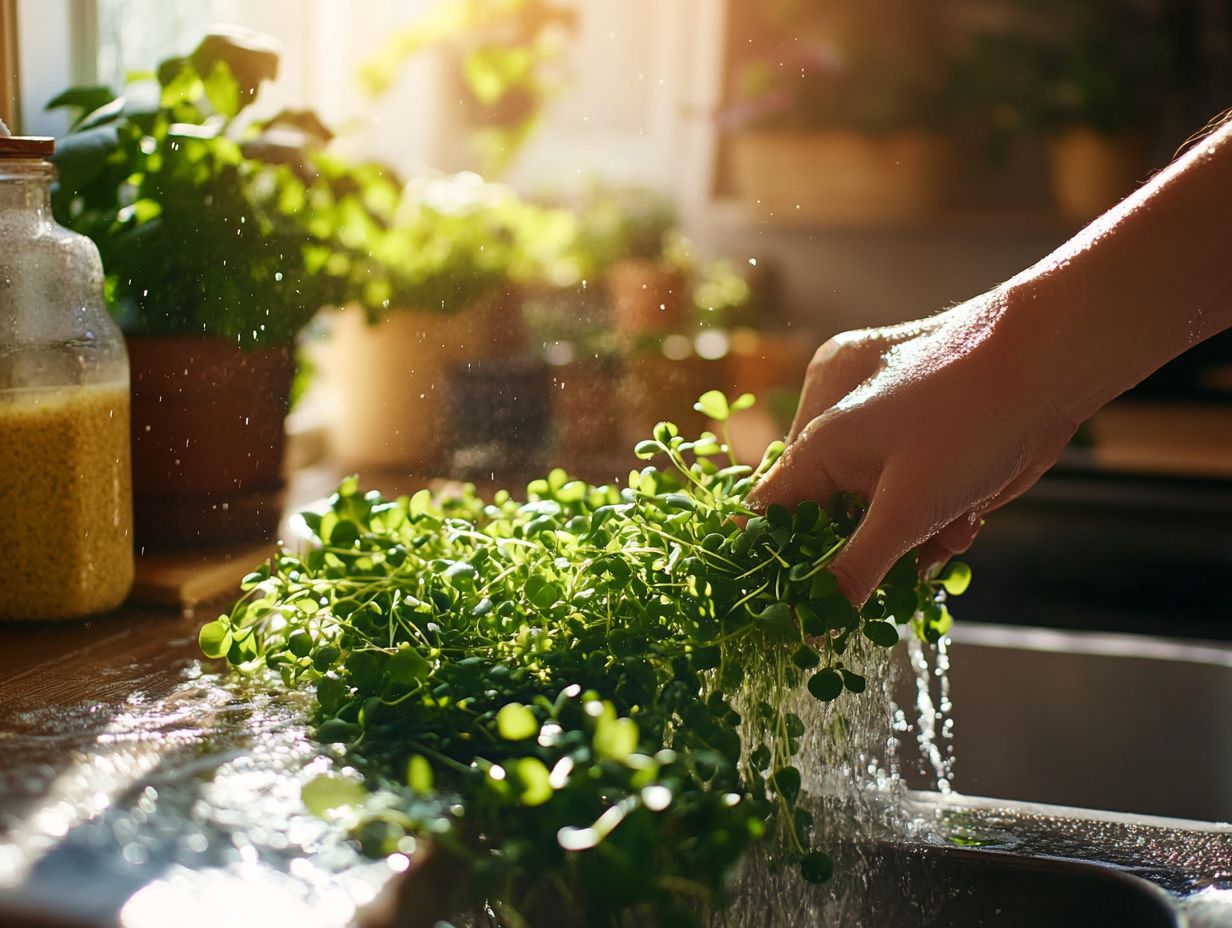
Yes, it is recommended to store microgreens in the refrigerator after harvest. Place them in an airtight container or wrap them in a damp paper towel to keep them fresh. They can be kept in the fridge for up to a week.
How often should I water microgreens after harvest?
It is important to keep the soil moist, but not too wet, after harvest. Water the microgreens lightly once a day or every other day. You can also mist them with water to prevent over-watering.
Can I freeze microgreens after harvest?
You can freeze microgreens after harvesting. Keep in mind that this may change their texture and flavor. Use frozen microgreens in cooked dishes for the best experience.
How long do microgreens last after harvest?
Microgreens can last up to a week in the refrigerator if stored properly. For the best taste, consume them within a few days.
What is the best way to store microgreens after harvest?
Store microgreens in an airtight container or wrap them in a damp paper towel. This method keeps them fresh and prevents wilting.

